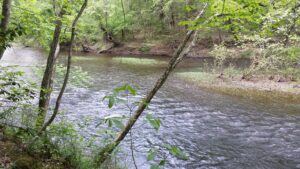
NORTH ANNA: THE OVERLOOKED BATTLEFIELD By DAVID LENTZ
Part I “On May 25 and 26 cannon and sharpshooter fire was almost constant across the river. During this period the Union artillery, firing at the rate of about three rounds per minute, hurled at least 3,000 rounds into these ridges and ravines. On May 26, Union gunners opened fire with three cohorn mortars, but failed to silence Confederate artillery.” Stop 10 (Gray line), North Anna Battlefield, Doswell, Virginia
Little did I know when I stopped my car just on the north side of the bridge spanning the North Anna River on U.S. Route 1 several months ago that I was in the middle of a battlefield where the two greatest armies of the Civil War once squared off for four days of what, I’ve ultimately learned, was a very serious battle. What made this realization so astounding was that I was once a student at nearby Randolph-Macon College and had travelled this road quite often over the years. Unfortunately, most of my college history courses centered on world history; my last American history course being in the tenth grade. I made the discovery that a battle had taken place at North Anna only because I feared that I had a flat tire and was forced to the side of the road where I saw a small sign indicating that General Robert E. Lee and Lt. Gen. Ulysses S. Grant had fought there. In any event, the episode led me to investigate a battle that I found, upon investigation, deserves far more attention than it usually gets.
On many levels, it is very difficult to understand why the Battle of North Anna is not more famous than it is. After all, the fighting was, in fact, intense. This is evidenced by the fact that the subject of the barrage quoted at the beginning of this article concerns just the third and fourth days of the battle. Moreover, the two armies, and the 120,000 troops of which they comprised, were led by the two most famous commanders of the Civil War, Lee and Grant, the latter, of course, ultimately becoming a President of the United States. These two opposing forces faced off across a relatively narrow and largely fordable shallow river just under 30 miles north of downtown Richmond on what was the major road between Washington and Richmond.
Perhaps the Battle of the North Anna isn’t better known because it was sandwiched between other more famous battles, such as the Wilderness and Spotsylvania Courthouse, on the one hand, both of which occurred before North Anna, and Cold Harbor and then Petersburg which occurred after. Perhaps it’s because there were “only” between four and five thousand casualties at North Anna. But, as I learned, these misleading casualty counts can be explained in large part because many of the troops were protected by the miles of trenches that they had dug that eventually presaged the fighting at both the Siege of Petersburg and, much later, during World War I. Severe thunderstorms also helped to keep casualties somewhat lower as did Grant’s ultimate realization that it was too dangerous to continue his assault on Lee’s commanding position above the river. In any event, it’s hard to argue that North Anna wasn’t a major battle.
What happened? Prelude to the Battle Lt. Gen. Ulysses S. Grant took command of all Union armies on March 3, 1864, less than three months before meeting Lee at North Anna. He and President Lincoln were of one mind. Grant would relentlessly engage Lee in battle in hopes of exhausting Lee’s depleted army, capturing Richmond and bringing the war to a quick, but belated, end. Lee, though still licking his wounds from Gettysburg, was initially able to hold his own against Grant in the first two rounds of what became known as Grant’s Overland Campaign. At the battle of the Wilderness and then at Spotsylvania Courthouse almost 40 miles north of North Anna, Lee’s army had stymied the conqueror of Vicksburg. After Spotsylvania, in May of 1864, Grant took direct aim at Richmond itself hoping on the way to capture a strategic railroad crossing at Hanover Junction located in what is now Doswell. This meant that Grant’s forces, the entire Army of the Potomac and Lt. Gen. Ambrose Burnside’s IX Corps, would be coming directly down the primary road between Washington and Richmond and, if they could capture Hanover Junction, be positioned astride a critical supply line less than 30 miles from Richmond. A more direct and ominous threat to the Confederate capital could not have been imagined.